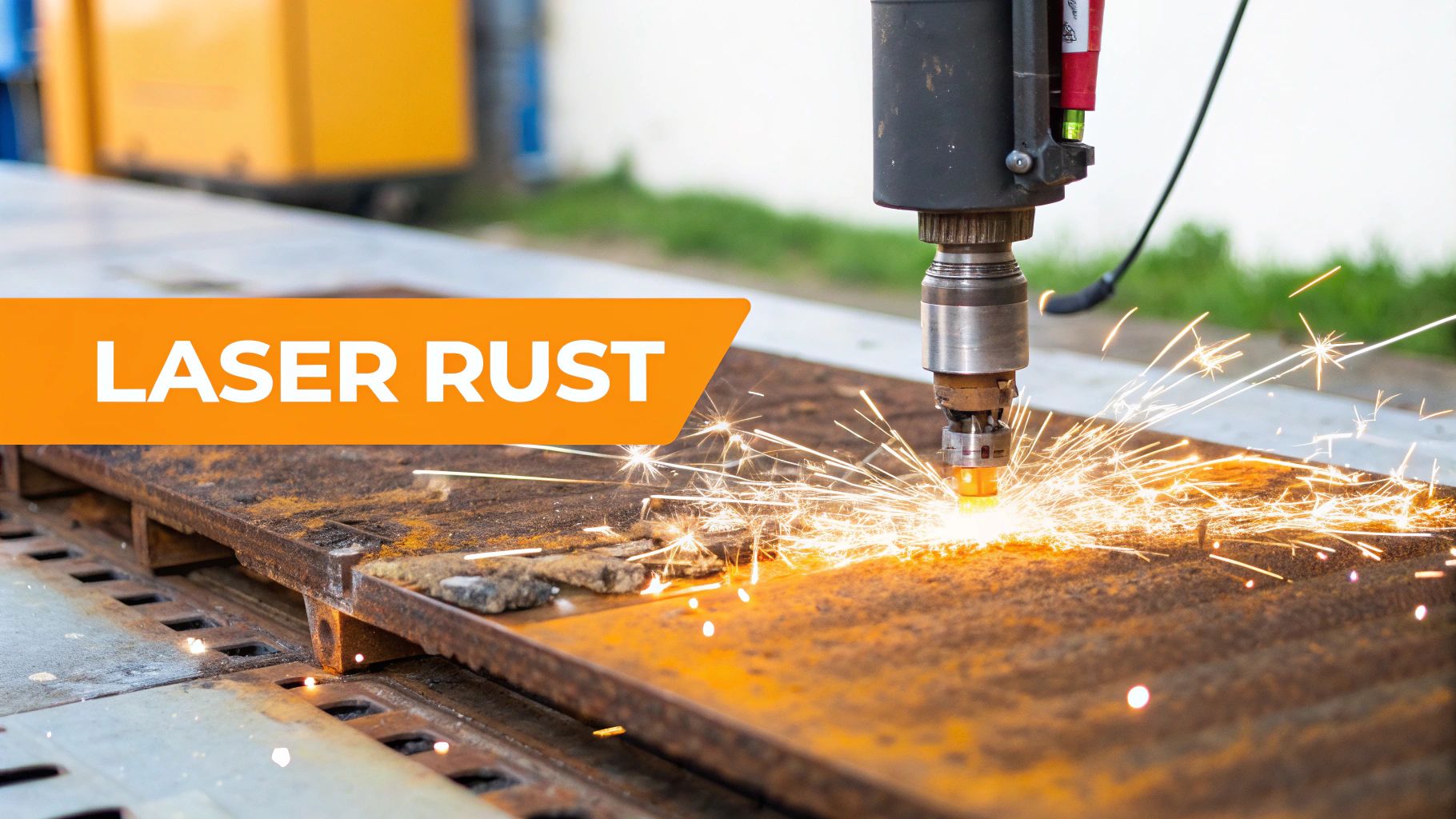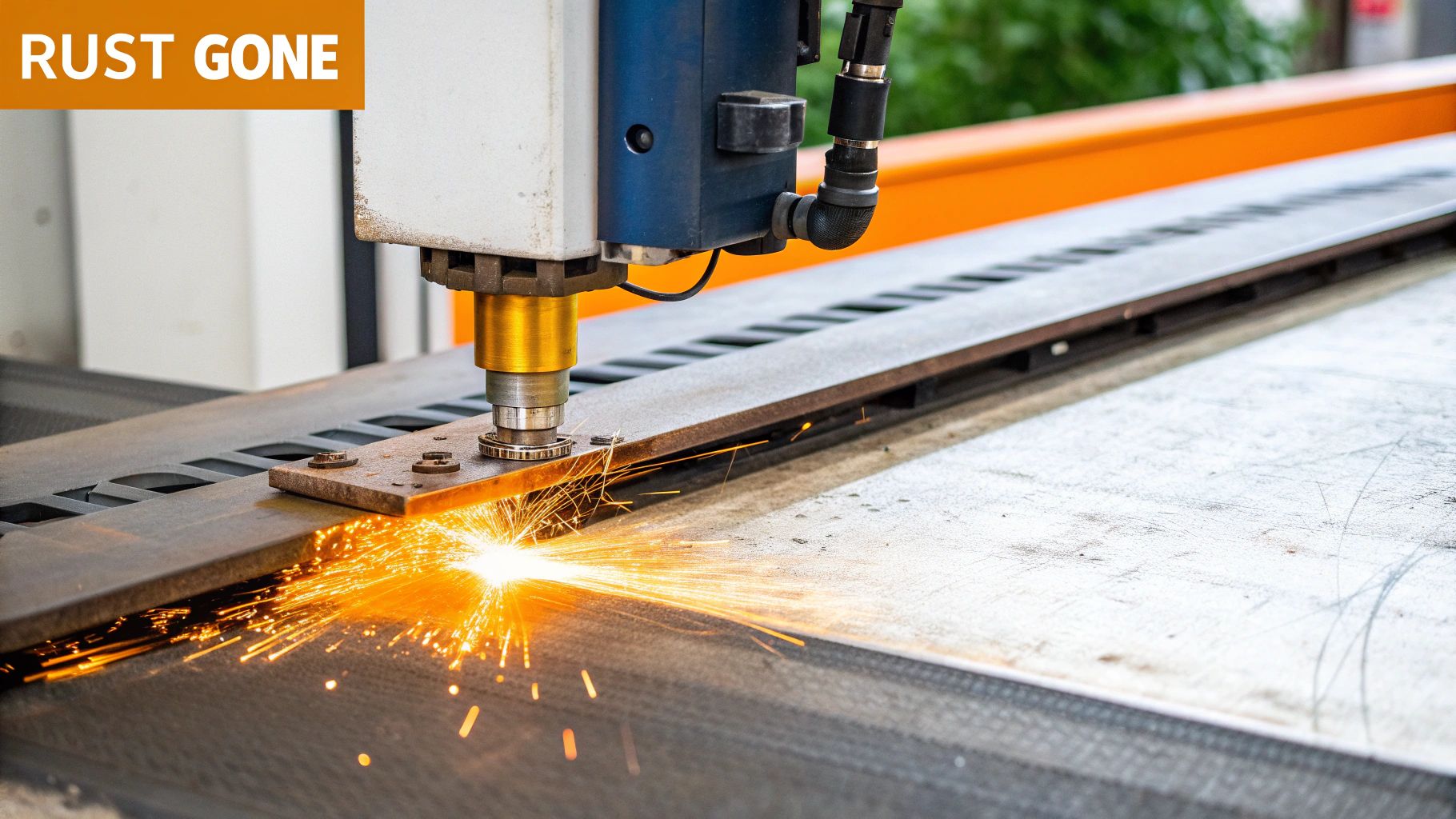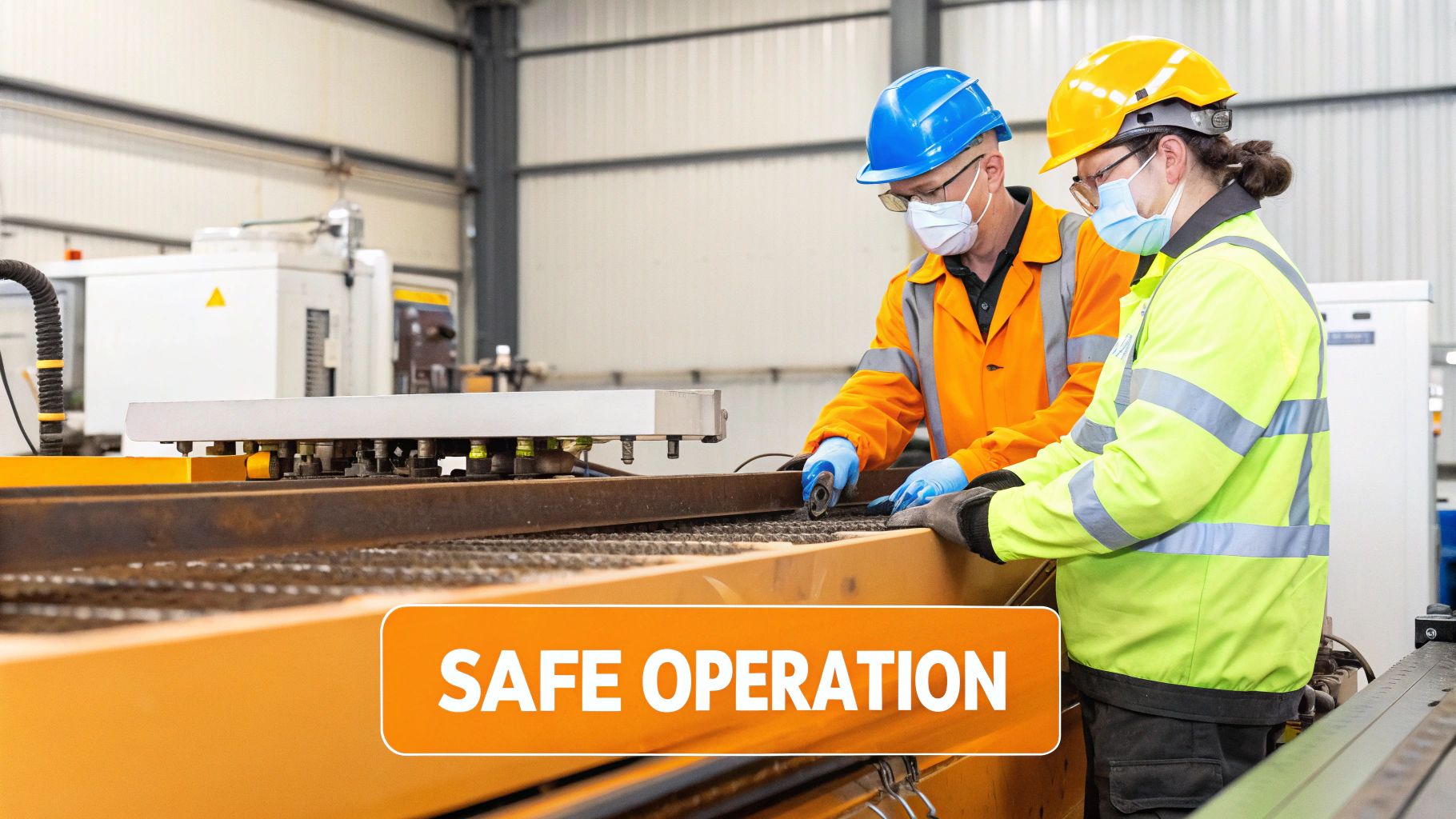レーザー錆除去技術の背後にある科学
レーザー錆除去は、光の力を利用して腐食を正確に除去する魅力的なプロセスです。高く集束されたレーザービームが錆びた表面に向けられます。ビームのエネルギーは錆に吸収され、急速な温度上昇を引き起こします。これによりアブレーションが発生し、錆が蒸発して下の金属は無傷のまま残ります。この精度は外科医のメスに匹敵します。
波長とその重要性
レーザーの波長は、効果的な錆の除去にとって重要です。異なる材料は異なる波長で光を吸収します。赤外線レーザーは、錆が赤外線光を効率的に吸収するため、金属の錆除去にしばしば好まれます。これにより、基材へのダメージが最小限に抑えられ、部品の完全性が保たれます。これは、ラジオを正しい周波数に調整するのに似ています。
アブレーションプロセスの詳細
アブレーションは、光と物質の間の複雑な相互作用です。レーザーが錆と相互作用する際、光エネルギーは熱エネルギーに変換されます。錆は固体から気体への急速な相転移を経て、効果的に蒸発します。これは非常に速く、ナノ秒のうちに起こり、プロセスの効率に寄与します。局所的な加熱は熱の拡散を防ぎ、基材を保護します。これは特に繊細な部品にとって重要です。
業界の成長と需要
この正確で非研磨的なアプローチは、産業全体でのレーザー錆除去の成長を促進しています。世界市場は大幅に拡大しています。2024年には市場価値が2億米ドルに達し、2033年までに4億5千万米ドルに達すると予測されており、2026年から2033年までの年平均成長率は9.5%です。この成長は、自動車、航空宇宙、製造業などの分野での効率的で環境に優しい表面準備とメンテナンスに対する需要の増加によって推進されています。レーザー錆除去は基材を保護し、部品の寿命を最大で30%延ばします。詳細な統計はVerified Market Reportsで確認できます。この拡大する市場は、正確で持続可能な産業ソリューションの必要性を浮き彫りにしています。部品の寿命を延ばす能力は、レーザー錆除去をコスト効果の高いものにしています。

レーザー錆除去が従来の方法を凌駕する理由

従来の錆除去方法、例えばサンドブラスト、研磨、化学処理などは、しばしば重大な課題を呈します。これらの方法は場合によっては効果的ですが、基材を損傷させたり、有害廃棄物を生じさせたりする可能性があります。レーザー錆除去は、これらの制限に対処し、いくつかの重要な利点を提供する魅力的な代替手段です。
精度と材料の保存
レーザー錆除去の主な利点は、その驚異的な精度です。マイクロンレベルで動作するレーザーは、外科医のメスのように、錆だけをターゲットにし、健全な材料には手を加えません。これは、基材を侵食し、その構造的完全性を損なう可能性のある研磨ブラスティングに対する大きな改善です。レーザー錆除去では、特に厳密な公差が求められる部品において、元の寸法を維持することが重要です。
環境責任
レーザー錆除去は、環境への影響を大幅に減少させます。危険な廃棄物を生成する従来の化学処理とは異なり、レーザー錆除去は乾燥プロセスです。生成される最小限の破片は主に蒸発した錆で構成されています。これにより、化学廃棄物処理コストが削減され、持続可能な産業慣行の必要性の高まりに合致します。レーザー錆除去のエネルギー効率は、エネルギー効率の良いスライディングドアなどの他の分野での進歩と同等です。
長期的なコスト効果
レーザーシステムの初期投資は高いですが、長期的なコストメリットは大きいです。継続的な費用は大幅に削減されます。サンドブラストのような研磨材や化学薬品の常時補充が不要だからです。主に電力で動くレーザー錆除去は、運用コストが大幅に低くなります。表面の損傷が減少することで、修理や交換の必要性も最小限に抑えられ、全体的な節約につながります。
複雑な部品における優れた結果
レーザー錆除去は、複雑な部品を扱う際に真価を発揮します。集束したレーザービームは狭いスペースや複雑な形状にアクセスでき、従来の方法では届かない場所から効果的に錆を除去します。この能力は、繊細または複雑な部品を復元し、その機能性と価値を保持するために重要です。レーザー技術についての詳細は、How to master....のようなリソースを探ってください。
業界専門家からのフィードバック
レーザー錆除去を業務に統合した業界の専門家は、著しい改善を報告しています。多くの人が、ダウンタイムの短縮と生産性の向上といった予期しない利点を強調しています。改善された作業者の安全性も、よく挙げられる利点の一つです。初期の学習曲線や既存のワークフローへの技術統合といった課題は残っていますが、レーザー錆除去は価値のある投資であるという合意があります。
レーザー錆除去の利点をさらに示すために、従来の方法と比較した表を見てみましょう:
レーザー錆除去 vs. 従来の方法
効果、環境への影響、精度、コストの考慮を含む主要な要因におけるさまざまな錆除去技術の包括的な比較
| 方法 | 精度 | 環境影響 | 表面損傷リスク | スピード | 初期費用 | 運用コスト |
|---|---|---|---|---|---|---|
| レーザーによる錆除去 | 非常に高い | 低 (最小限の破片) | 非常に低い | 適度 | 高い | 低い |
| サンドブラスト | 低い | 中程度(ほこり、メディア廃棄) | 高い | 高い | 適度 | 適度 |
| 研削 | 適度 | 低い | 適度 | 低い | 低い | 低い |
| 化学処理 | 低い | 高(有害廃棄物) | 適度 | 適度 | 低い | 高い |
上の表は、異なる錆除去技術の主要なトレードオフを強調しています。レーザー錆除去は精度、環境への影響、表面の保護に優れていますが、初期コストが高くなります。従来の方法は、初期費用が安いことが多いですが、表面損傷や環境問題のリスクが高くなります。最適な選択は、プロジェクトの具体的な用途と優先事項によります。
主要産業における実世界の応用
レーザー錆除去は、さまざまな業界で貴重なツールであることが証明されており、従来の錆除去方法に代わる正確で効率的な選択肢を提供しています。繊細な歴史的遺物の修復から、重工業の清掃の効率化まで、この適応性のある技術はさまざまな分野の独自の課題に取り組んでいます。
自動車の復元と製造
自動車修復の分野において、レーザー錆除去は技術者が従来の方法よりもはるかに速く、完璧でショー品質の仕上がりを実現することを可能にします。レーザーの精度は、クラシックカー修復の重要な側面であるオリジナル部品の保存を保証します。修復を超えて、レーザークリーニングはタイヤ金型の清掃やブレーキラインの装飾などのプロセスにおいて自動車製造でも注目を集めています。
航空宇宙の精度と安全性
航空宇宙産業は、特に重要な安全部品に関して、厳密な注意を必要とします。レーザー錆除去は、マイクロメートルレベルの清掃を提供し、重要な部品の完全性を保証します。この精度は、航空機のメンテナンスや製造において非常に重要であり、わずかな腐食でも深刻な影響を及ぼす可能性があります。
製造効率と持続可能性
製造工場は、生産ラインの効率を最適化するために、ますますレーザー錆除去を採用しています。レーザーの速度と精度は、サンドブラストなどの方法と比較してダウンタイムを大幅に削減し、生産性の向上と大幅なコスト削減を実現します。さらに、最小限の廃棄物を生成するレーザー錆除去の環境に優しい性質は、持続可能な実践への関心の高まりと一致しています。このエコ意識の高いアプローチは、2023年に$0.66 billionに達し、2032年までに$1.15 billionに達すると予測される拡大する市場に反映されています。Straits Researchによる報告です。
歴史的遺物の保存
産業用途を超えて、レーザー錆除去は私たちの共有する歴史を守る上で重要な役割を果たしています。その優しく、非研磨的な特性により、保存修復士は脆弱な遺物から腐食を取り除くことができ、基材を傷めることがありません。この技術は、代々にわたって取り返しのつかない歴史的な作品を保護し、修復するための強力な手段を提供します。
医療機器の滅菌
医療分野では、機器の清潔さと滅菌を維持することが最も重要です。レーザー錆除去は、精密医療機器を清掃する非常に効果的な方法を提供し、機能性を損なうことなく腐食を排除し、患者の安全を脅かすこともありません。また、これらのしばしば高価な医療機器の寿命を延ばすことにも寄与します。

特定のニーズに合わせたレーザー技術の適応
各業界は独自の課題を提示しており、レーザー錆除去システムはこれらの特定の要件に応じた柔軟性を提供します。現場での修復のためのポータブルシステムであれ、製造施設のための大規模な自動化セットアップであれ、技術は用途に応じて適応します。この適応性により、レーザー錆除去は多様な分野での汎用性が高く実用的なソリューションとなっています。技術が進歩するにつれて、レーザー錆除去の適用範囲はますます広がり、錆に関連する課題に対処するためのより効率的で精密なソリューションが約束されています。
完璧なレーザー錆除去システムの選択

すべてのレーザー錆除去システムが同じではありません。特定のニーズに合ったシステムを選ぶことは、効率を最大化し、投資収益率を向上させるために重要です。これは、購入前にいくつかの重要な要素を慎重に考慮することを意味します。このセクションでは、完璧なレーザー錆除去システムを選択するために必要な仕様と考慮事項を案内します。
電力要件の理解
レーザーの出力は、錆除去効率に直接影響します。小さなまたはより複雑なアイテムの軽い錆除去には、低出力(50-200W)のパルスレーザーシステムが十分かもしれません。
しかし、より重い錆の除去や大きな表面積は、しばしばより多くのパワーを必要とします。これらの厳しい作業には、中程度の(300-500W)パルスレーザーや、さらには高出力の(1000-3000W)連続波(CW)レーザーが必要になるかもしれません。適切な工具を選ぶことに例えると、小さなハンマーは大きな釘を打つのには効果的ではないのと同様に、低出力のレーザーは厚い錆の層に苦労するかもしれません。
最適な結果のための波長選択
レーザー光の波長は、もう一つの重要な要素です。異なる金属は異なる波長で光を吸収します。赤外線レーザーは、錆による高い吸収率のため、金属の錆除去に人気の選択肢です。
このターゲット吸収は、基材の金属へのダメージを最小限に抑え、部品の完全性を保ちながら効果的な錆の除去を保証します。
モビリティとインストールの考慮事項
フィールド作業のためにポータブルシステムが必要か、固定された場所のためにステーショナリーシステムが必要かを考慮してください。ポータブルシステムは、現場でのアプリケーションに柔軟性を提供し、大型機器をその場で修復するのに役立ちます。
一方、固定システムは通常、より強力で製造施設内の大量生産に適しています。この決定は、システムのサイズ、電力要件、全体的なコストに大きな影響を与えます。
自動化と統合オプション
高容量のアプリケーションでは、自動化が重要です。ロボットレーザー錆除去システムは、生産性と一貫性を大幅に向上させますが、初期投資が高くなります。現在のワークフローと生産ニーズを評価して、スループットの向上が追加コストを正当化するかどうかを検討してください。
これらの自動化システムは、既存の生産ラインに統合でき、製造プロセスをさらに改善します。詳細を学ぶことに興味があるかもしれません: マスターする方法....
真の所有コストの計算
初期購入価格を超えて考え、メンテナンス、修理、消耗品を含む長期的な運用コストを考慮してください。レーザーシステムは一般的に従来の方法よりも運用コストが低いですが、これらの費用を考慮することは、総所有コストを計算するために重要です。これにより、異なるシステム間でのより現実的な比較が可能になり、十分な情報に基づいた意思決定を行うのに役立ちます。たとえば、出力が高いシステムは初期コストが高いかもしれませんが、効率の向上を通じて長期的な節約を提供することがあります。
ベンダーに尋ねるべき重要な質問
異なるレーザー錆除去システムを評価する際には、適切な質問をすることが重要です。システムの保証、サービス契約、技術サポートについて問い合わせてください。ベンダーのアフターサポートを理解することで、時間とお金を節約できます。また、チームがシステムを効果的に操作し、維持できるように、トレーニングプログラムや利用可能なリソースについても尋ねてください。
真の価値を提供する機能
すべての機能が同じように有益であるわけではありません。運用ニーズに直接対応する機能に焦点を当ててください。一部のオペレーションでは、最適なパフォーマンスのために調整可能な電力設定とリアルタイム監視を優先しています。
他の人は統合ダストコレクションや安全機能を優先するかもしれません。特定の要件に焦点を当てることで、特定のアプリケーションに対して限られた価値しか提供しない機能に対して支払うことを避けることができます。
以下の表は、異なるニーズに基づいて適切なレーザー錆除去システムを選択するためのガイドを提供します。
レーザー錆除去システム選定ガイド さまざまな用途や環境に応じたレーザー錆除去システムを選定する際に考慮すべき主要仕様
| アプリケーションタイプ | 推奨電力 | 理想的な波長 | モビリティ要件 | 主な特徴 | 価格帯 |
|---|---|---|---|---|---|
| 小物の軽い錆取り | 50-200Wパルス | 赤外線 | ポータブル | 調整可能な電源設定 | より低い |
| 大面積の重度の錆除去 | 1000-3000W 連続波 | 赤外線 | 文房具 | ロボット統合 | より高い |
| 自動車復元 | 300-500Wパルス | 赤外線 | ポータブル | リアルタイムモニタリング | ミッドレンジ |
| 産業用クリーニング | 1000+W CW | 赤外線 | 文房具 | 統合ダストコレクション | より高い |
この表は、レーザー錆除去システムを選択する際に関与する主要な要因を要約しており、アプリケーションの種類、電力要件、および重要な機能との関係を強調しています。
ニーズに合ったシステムの選択
適切なレーザー錆除去システムを選ぶことは、重要な投資です。運用ニーズを慎重に評価し、主要な仕様を理解し、ベンダーに適切な質問をすることで、効率を最大化し、運用コストを削減し、強力な投資収益率を提供するシステムを選択できます。完璧なシステムは、あなたの特定の要件と予算に最も合致するものです。
レーザー錆除去プロセスの習得
レーザー錆除去は、従来の方法と比較して大きな利点を提供しますが、最良の結果を得るためにはプロセスを深く理解する必要があります。このガイドでは、初期評価から最終検査まで、レーザー錆除去をマスターするためのステップバイステップのアプローチを提供します。
表面状態の評価
レーザー錆除去プロセスを開始する前に、錆びた表面の徹底的な評価が重要です。これには、金属の種類、錆の程度、およびコーティングや汚染物質の存在を特定することが含まれます。この情報は、適切なレーザーのパラメータを決定するのに役立ち、基材を損傷することなく効果的に錆を除去することを保証します。たとえば、重度に錆びた鋳鉄は、軽度に錆びたアルミニウムとは異なる設定が必要です。
重要な安全プロトコルの実施
レーザー錆除去は高出力の機器を使用するため、安全が最も重要です。適切な個人用保護具(PPE)、レーザー安全眼鏡、手袋、保護服を含む、はオペレーターを危険から守るために不可欠です。作業エリアは、プロセス中に生成される煙や粒子を除去するために十分に換気されている必要があります。これにより、関与するすべての人にとって安全な環境が確保されます。
レーザーパラメータの設定
レーザー錆除去の成功は、正しいパラメータ設定に依存します。これには、正しいレーザー出力、パルス周波数、およびスキャン速度の選択が含まれます。これらのパラメータは、材料と錆の厚さに基づいて調整されます。厚い錆には高い出力設定が必要な場合がありますが、繊細なアイテムには低い出力設定が適しています。正しい設定はプロセスを最適化し、損傷のリスクを最小限に抑えます。
体系的な清掃技術
効果的なレーザー錆除去には、体系的なアプローチが必要です。レーザービームは、錆びた表面を一貫した制御されたパターンで移動させ、完全なカバレッジを確保する必要があります。頑固な錆には、重ねて通過することが必要な場合があります。芝生を刈るのと同様に、体系的な通過は徹底的なカバレッジを保証し、見落としを防ぎます。この方法は、完全な錆除去を確実にし、基材を保護します。
リアルタイム監視と品質管理
プロセスをリアルタイムで監視することは、品質管理にとって重要です。清掃された表面の色と質感を観察することで、プロセスがどれだけうまく機能しているかを示します。最適な結果を得るために、必要に応じてレーザーのパラメータを調整できます。この即時の是正措置は、再作業を防ぎ、一貫した高品質の仕上がりを確保します。
清掃後の検査と仕上げ
レーザー錆除去プロセスが完了した後、徹底的な検査が必要です。これには、残っている錆や表面の欠陥を探すことが含まれます。望ましい仕上がりに応じて、さらなる清掃や表面処理が必要になる場合があります。この最終ステップは、部品が必要な仕様を満たし、次の段階に進む準備が整っていることを確認します。
一般的な課題のトラブルシューティング
レーザー錆除去中にいくつかの課題が発生する可能性があります。反射面はレーザービームを散乱させ、その効果を減少させることがあります。深くえぐれた錆は、複数回の通過や専門的な技術を必要とする場合があります。定期的なシステムキャリブレーションも、最適なパフォーマンスを維持するために重要です。これらの課題に迅速に対処することで、効果的な錆除去が確保されます。レーザー技術、レーザー溶接やDIYファイバーレーザー溶接に関する詳細情報は、Laser Insights Chinaをご覧ください。このリソースは、愛好者や専門家のためにレーザーの世界に関する貴重な洞察を提供します。
レーザー錆除去のビジネスケースを作成する
レーザー錆除去への投資は、初期コストがかなり高いように思えるかもしれません。しかし、長期的な財務的利益を詳しく見てみると、魅力的な投資利益率 (ROI)と全体的なコスト効率が明らかになります。このセクションでは、レーザー錆除去の実施における財務的側面を検討し、どのようにして大幅なコスト削減と利益の増加に寄与するかを示します。
初期投資と運営コストの分析
レーザー錆除去システムの初期投資は、出力、機能、携帯性などの要因によって異なります。初期コストは従来の錆除去方法よりも高くなることがありますが、継続的な運用コストはかなり低くなります。レーザー錆除去は、研磨材や化学薬品などの消耗品を必要としないため、継続的なコスト削減につながります。レーザー技術の精度は、基材への損傷を最小限に抑え、修理や交換の必要性を減らします。エントリーレベルのシステムは約$3,000から始まり、強力な産業用システムは$100,000を超えることがあります。この範囲により、企業は予算と運用要件に合ったシステムを選択できます。レーザー錆除去システムのコストについて詳しく学ぶ。
ROIと回収期間の計算
レーザー錆除去に切り替える企業は、しばしば8か月から24か月の回収期間を見込むことができます。この迅速なリターンは、いくつかの重要な要因によって促進されています:
-
労働時間の削減: レーザー錆除去の速度と効率は、研磨やサンドブラストのような手動方法と比較して、労働時間を大幅に削減します。
-
材料保護: レーザー精度は基材へのダメージを最小限に抑え、その価値を保ち、廃棄物を削減します。
-
ダウンタイムの削減: より速い清掃時間は、設備のダウンタイムを減少させ、生産性と収益を向上させます。
-
より高品質な結果:レーザー錆除去は優れた表面仕上げを生み出し、追加の加工が不要になることが多く、作業を効率化し、コストを削減します。
多様な業界におけるケーススタディ
レーザー錆除去の経済的利点は、さまざまな分野で明らかです。自動車修復工場は、時間の大幅な節約と品質の向上を報告しており、その結果、顧客満足度と収益性が向上しています。航空宇宙分野では、重要な部品の正確な清掃が高額な故障のリスクを最小限に抑え、貴重な機器の寿命を延ばします。製造業者は、生産ラインの効率が向上し、材料の無駄が減少することで、かなりのコスト削減と全体的なパフォーマンスの向上を享受しています。
段階的実施のための戦略
初期投資に躊躇している企業にとって、段階的な導入は実用的な解決策を提供します。特定のタスクのために小型でポータブルなシステムから始めることで、企業はレーザー技術の利点を直接体験できます。その後、必要に応じて投資を徐々に増やすことができ、初期の財務リスクを最小限に抑え、自分のペースで技術に適応することができます。
市場の成長と競争優位性
錆除去市場は、化学的および機械的手法の両方を含み、2032年までに$789.27百万に達する見込みです。この予測される成長は、効率的な腐食除去ソリューションに対する需要の高まりを示しています。レーザー錆除去を採用することで、優れた品質、迅速なターンアラウンドタイム、環境に優しいサービスを提供し、競争上の優位性を得ることができます。このトピックをさらに探る。この積極的な戦略は、持続可能な産業慣行を促進しながら、成長する市場での成功に向けて企業を位置づけます。
レーザー錆除去革新の未来
レーザー錆除去技術は常に進化しています。現在の進展は、この技術が達成できることの始まりに過ぎません。今後の研究開発は、より効率的で、正確で、多用途なソリューションを約束しています。あなたが興味を持つかもしれないのは:中国からのレーザーインサイトです。
AI駆動の自動化
最も有望な進展の一つは、人工知能 (AI)の統合です。AIを活用したシステムが、錆の検出と除去を自動化するために開発されています。これには、アルゴリズムを訓練して錆のパターンを認識させ、最適な清掃のためにレーザーのパラメータを自動的に調整することが含まれます。これにより、効率が向上するだけでなく、手作業が減少し、熟練した労働者が解放されます。
エネルギー効率の良いレーザー源
より持続可能性を追求する動きが、エネルギー効率の良いレーザー源の開発を促進しています。これらのレーザーは、効果的な清掃を維持しながらエネルギー使用を最小限に抑えます。これにより、運用コストが低下し、環境への影響が小さくなります。例えば、新しいファイバーレーザー技術は、より少ないエネルギー入力で高い出力を提供し、経済的および環境的な利点に貢献しています。
ポータブルで現場対応可能なソリューション
レーザー錆除去は、ポータブルシステムの開発により、よりアクセスしやすくなっています。これにより、技術の適用範囲が広がり、現場でのメンテナンスや修理に技術が持ち込まれます。ポータブルシステムは、以前は現場での錆除去が困難だった建設やインフラなどの産業に新たな機会を創出します。
IoTプラットフォームとの統合
レーザー錆除去システムをモノのインターネット (IoT)プラットフォームと統合することは、エキサイティングな可能性を提供します。これにより、清掃プロセスのリアルタイムデータ収集と分析が可能になります。これらのデータ駆動型の洞察は、予知保全、システムパフォーマンスの最適化、故障の防止に利用できます。IoT接続により、リモート監視と制御も可能になり、運用効率が向上します。
規制の変更と業界の採用
環境規制は、レーザー錆除去の広範な採用に影響を与えています。サンドブラストや化学処理などの従来の方法は、その環境への影響についての厳しい監視に直面しています。レーザー技術は、よりクリーンで持続可能な代替手段を提供します。この規制の推進と持続可能性の利点に対する意識の高まりが相まって、多くの業界でレーザー錆除去への移行が加速しています。この環境に配慮した技術への移行は、環境への影響を減らそうとする企業にとって、レーザー錆除去の価値を高めています。
レーザー錆除去の未来は明るいです。これらの進歩は、この技術の効率、精度、汎用性を向上させることを約束しており、運営の卓越性と持続可能性を求める企業にとって、さらに重要なツールとなるでしょう。
高度なレーザー技術の世界にさらに深く踏み込む準備はできましたか?Laser Insights Chinaを訪れて、レーザー溶接、クリーニング、切断の最新の革新を探求してください。

